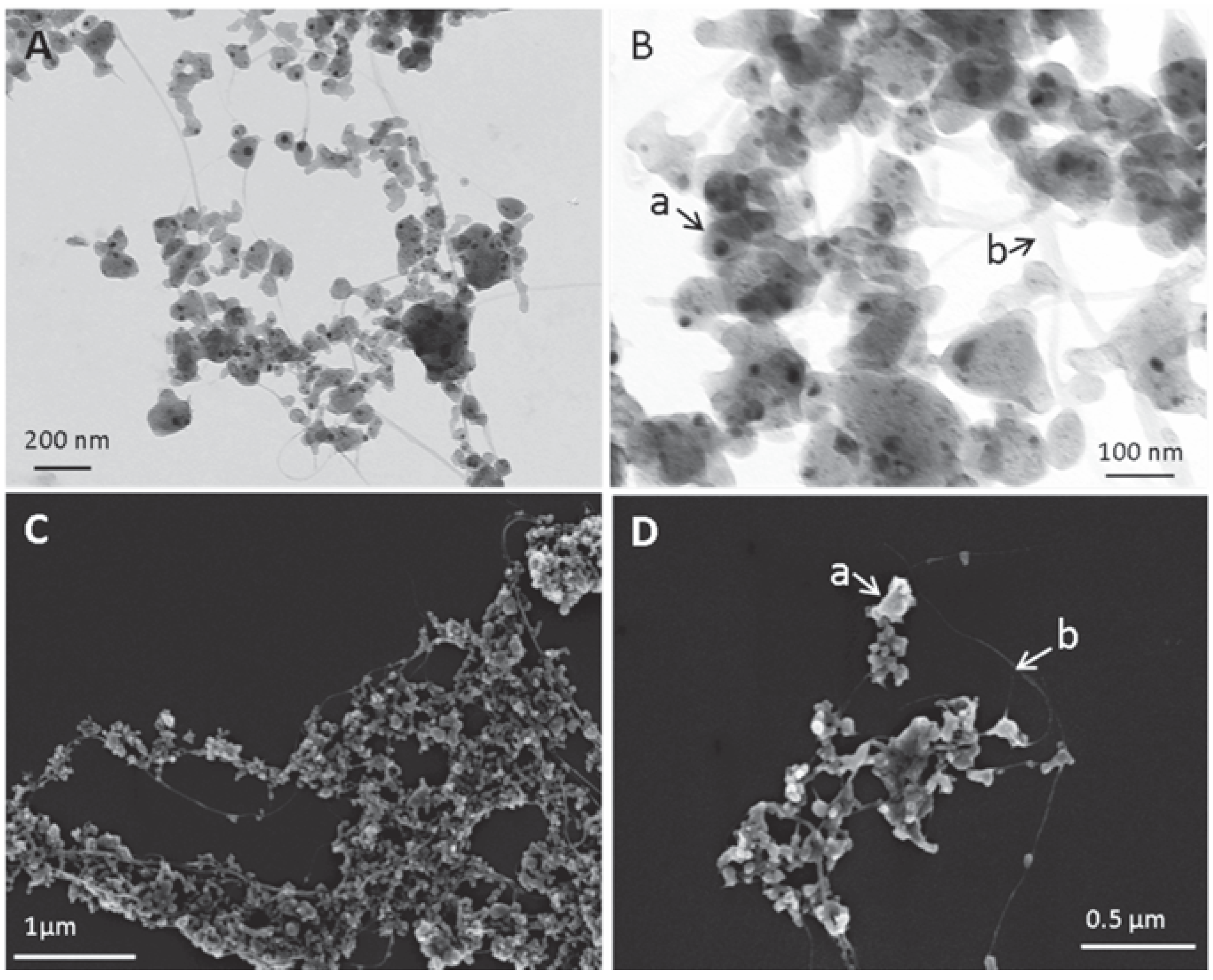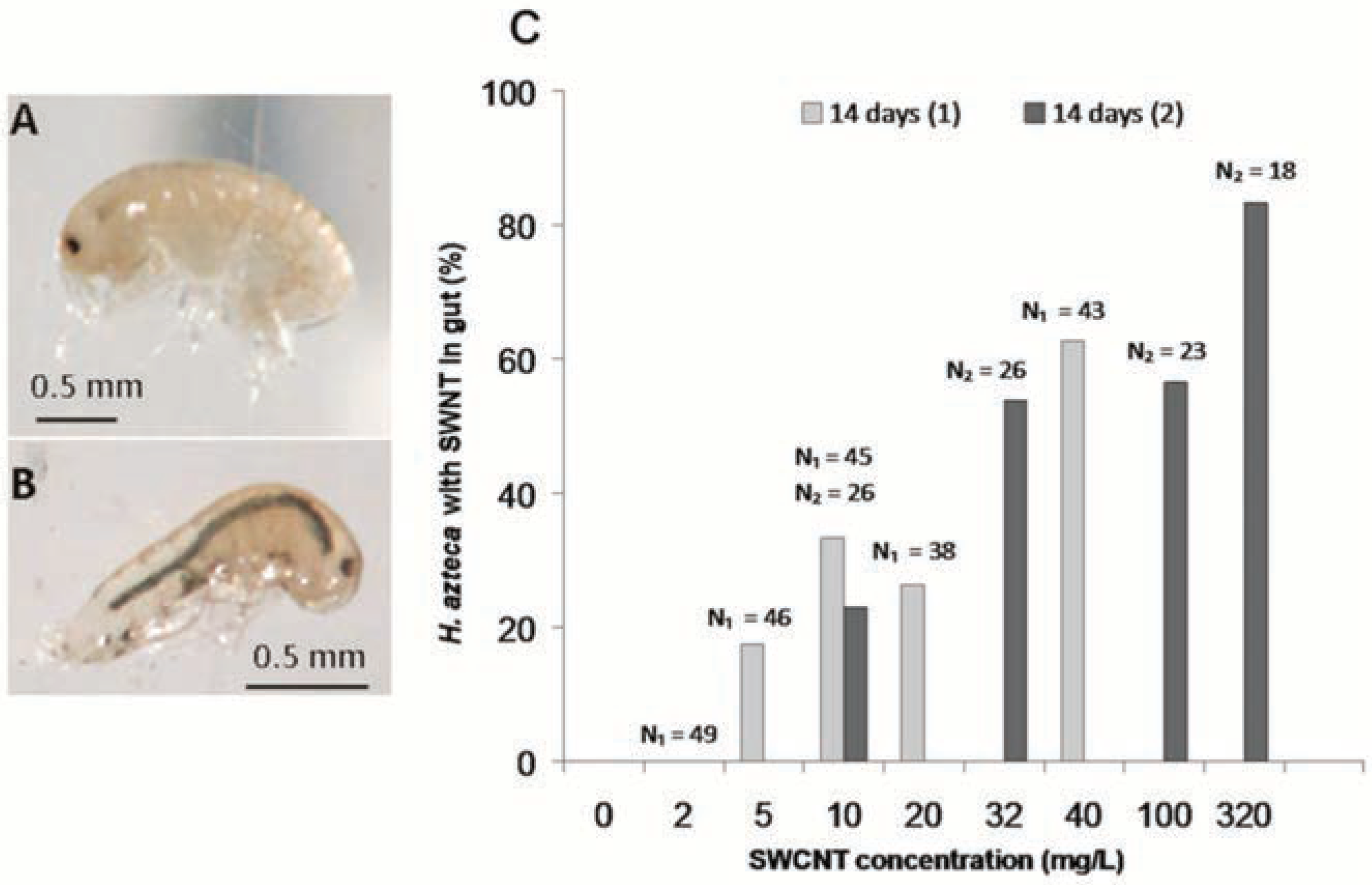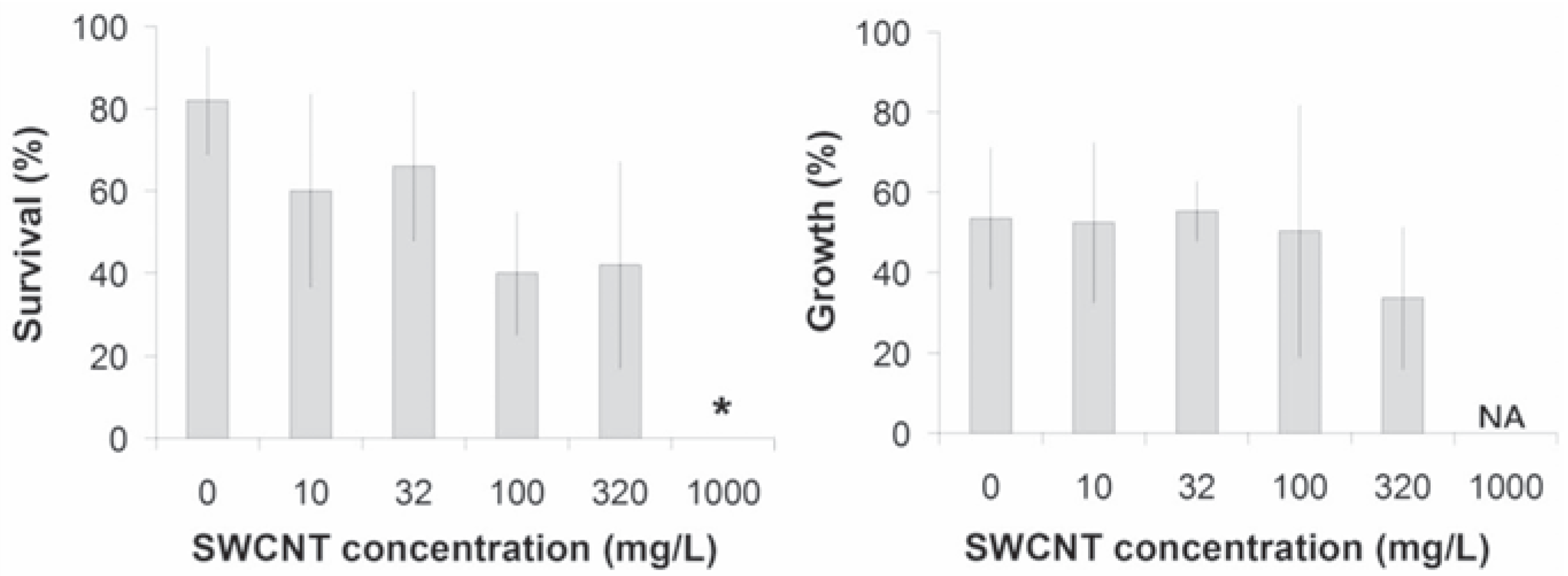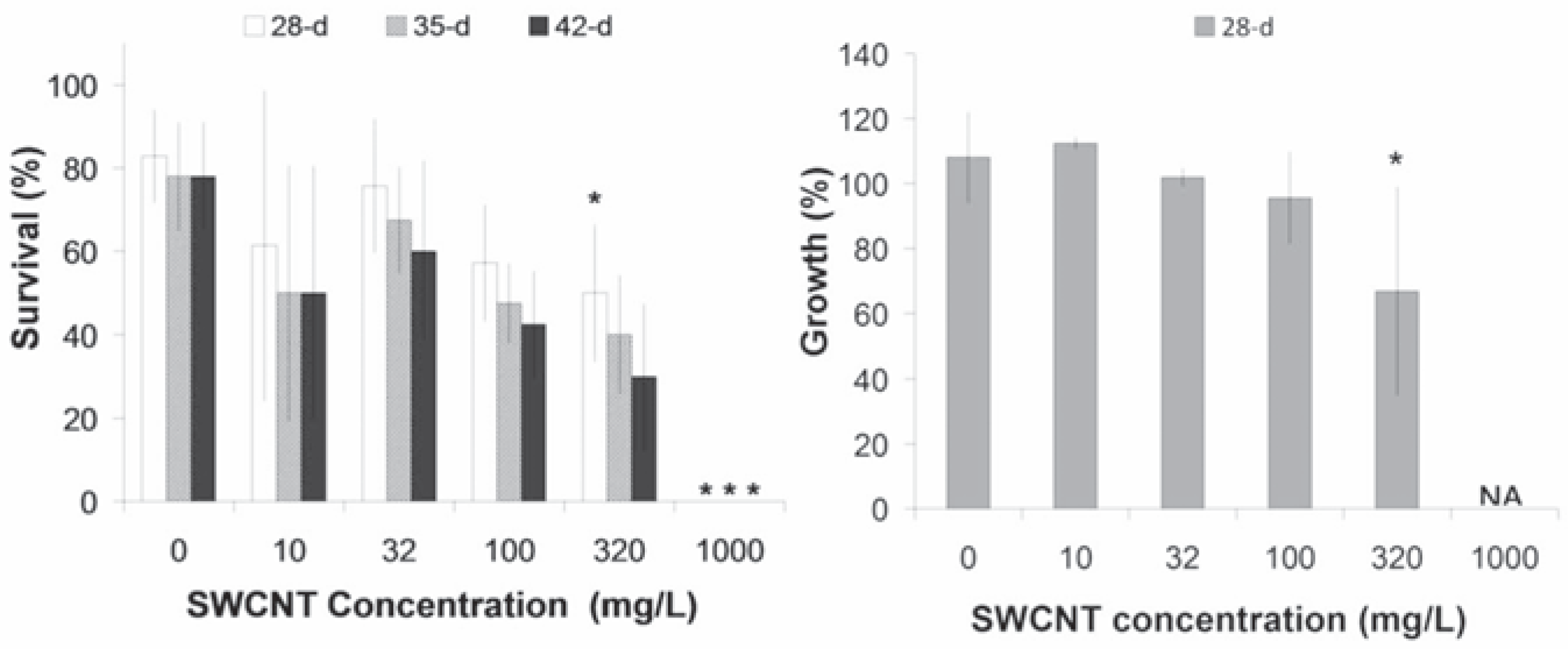Single-Walled Carbon Nanotubes Toxicity to the Freshwater Amphipod Hyalella azteca: Influence of Sediment and Exposure Duration
Abstract
:Introduction
Materials and Methods
Characterization and preparation of single-walled carbon nanotubes

Test organisms and artificial sediment
Toxicity test and quality control
Effects of acute and chronic exposure
Effects of a filtered solution of single-walled carbon nanotubes
Influence of sediment presence on toxicity
Observation of test organisms
Data analysis
Results and Discussion
Characterization of dry test product and prepared solutions
Toxicity of single-walled carbon nanotubes: influence of exposure time
Toxicity of a filtered single-walled carbon nanotubes solution
Toxicity of single-walled carbon nanotubes: influence of sediment
Conclusions
Research highlights
Contributions
Acknowledgments
Conflicts of Interest
References
- Dresselhaus, MS; Dresselhaus, G; Jorio, A. Unusual properties and structure of carbon nanotubes. Ann Rev Mater Res 2004, 34, 247–78. [Google Scholar]
- Wijnhoven, SWP; Oomen, IAG; Sips, AJAM; Bourgeois, FC; te Dorsthorst, GJPM; Kooi, MW; et al. Development of an inventory for consumer products containing nanomaterials: final report. ENV/D3/SER/2010/0060r 2011; European commission. Available from: http://ec.europa.eu/environment/chemicals/nanotech/pdf/study_inventory.pdf.
- Panyam, J; Labhasetwar, V. Biodegradable nanoparticles for drug and gene delivery to cells and tissue. Adv Drug Deliv Rev 2003, 55, 329–47. [Google Scholar]
- Liu, X; Wang, M; Zhang, S; Pan, B. Application potential of carbon nanotubes in water treatment: a review. J Environ Sci 2013, 25, 1263–80. [Google Scholar]
- US National Nanotechnology Initiative. NNI budget. 2013. Accessed: 15 February, 2015. Available from: http://www.nano.gov/about-nni/what/funding.
- Li, M; Huang, CP. The responses of Ceriodaphnia dubia toward multi-walled carbon nanotubes: effect of physical-chemical treatment. Carbon 2011, 49, 1672–9. [Google Scholar]
- Youn, S; Wang, R; Gao, J; Hovespyan, A; Ziegler, KJ; Bonzongo, JCJ; et al. Mitigation of the impact of single-walled carbon nanotubes on a freshwater green algae: Pseudokirchneriella subcapitata. Nanotoxicology 2012, 6, 161–72. [Google Scholar]
- Boyle, D; Fox, JE; Akerman, JM; Sloman, KA; Henry, TB; Handy, RD. Minimal effects of waterborne exposure to single-walled carbon nanotubes on behaviour and physiology of juvenile rainbow trout (Oncorhynchus mykiss). Aquat Toxicol 2014, 146, 154–64. [Google Scholar]
- Petersen, EJ; Zhang, L; Mattison, NT; O’Carroll, DM; Whelton, AJ; Uddin, N; et al. Potential release pathways, environmental fate, and ecological risks of carbon nanotubes. Environ Sci Technol 2011, 45, 9837–56. [Google Scholar]
- Templeton, RC; Ferguson, PL; Washburn, KM; Scrivens, WA; Chandler, GT. Life-cycle effects of single-walled carbon nanotubes (SWNTs) on an estuarine meiobenthic copepod. Environ Sci Technol 2006, 40, 7387–93. [Google Scholar]
- Blaise, C; Gagné, F; Férard, JF; Eullaffroy, P. Ecotoxicity of selected nano-materials to aquatic organisms. Environ Toxicol 2008, 23, 591–8. [Google Scholar]
- Velzeboer, I; Kupryianchyk, D; Peeters, ETHM; Koelmans, AA. Community effects of carbon nanotubes in aquatic sediments. Environ Int 2011, 37, 1126–30. [Google Scholar]
- Petersen, EJ; Akkanen, J; Kukkonen, JVK; Weber, WJ. Biological uptake and depuration of carbon nanotubes by Daphnia magna. Environ Sci Technol 2009, 43, 2969–75. [Google Scholar]
- Edgington, AJ; Roberts, AP; Taylor, LM; Alloy, MM; Reppert, J; Rao, AM; et al. The influence of natural organic matter on the toxicity of multiwalled carbon nanotubes. Environ Toxicol Chem 2010, 29, 2511–8. [Google Scholar]
- Jackson, P; Jacobsen, NR; Baun, A; Birkedal, R; Kühnel, D; Jensen, KA; et al. Bioaccumulation and ecotoxicity of carbon nanotubes. Chem Cent J 2013, 7, 154. [Google Scholar]
- Kennedy, AJ; Hull, MS; Steevens, JA; Dontsova, KM; Chappell, MA; Gunter, JC; et al. Factors influencing the partitioning and toxicity of nanotubes in the aquatic environment. Environ Toxicol Chem 2008, 27, 1932–41. [Google Scholar]
- Mwangi, JN; Wang, N; Ingersoll, CG; Hardesty, DK; Brunson, EL; Li, H; et al. Toxicity of carbon nanotubes to freshwater aquatic invertebrates. Environ Toxicol Chem 2012, 31, 1823–30. [Google Scholar]
- Cheng, J; Flahaut, E; Cheng, SH. Effect of carbon nanotubes on developing zebrafish (Danio Rerio) embryos. Environ Toxicol Chem 2007, 26, 708–16. [Google Scholar]
- Petersen, EJ; Henry, TB. Methodological considerations for testing the ecotoxicity of carbon nanotubes and fullerenes: review. Environ Toxicol Chem 2012, 31, 60–72. [Google Scholar]
- Petersen, EJ; Henry, TB; Zhao, J; MacCuspie, RI; Kirschling, TL; Dobrovolskaia, MA; et al. Identification and avoidance of potential artifacts and misinterpretations in nanomaterial ecotoxicity measurements. Environ Sci Technol 2014, 48, 4226–46. [Google Scholar]
- Parks, AN; Portis, LM; Schierz, PA; Washburn, KM; Perron, MM; Burgess, RM; et al. Bioaccumulation and toxicity of single-walled carbon nanotubes to benthic organisms at the base of the marine food chain. Environ Toxicol Chem 2013, 32, 1270–7. [Google Scholar]
- Fraser, TWK; Reinardy, HC; Shaw, BJ; Henry, TB; Handy, RD. Dietary toxicity of single-walled carbon nanotubes and fullerenes (C60) in rainbow trout (Oncorhynchus mykiss). Nanotoxicology 2011, 5, 98–108. [Google Scholar]
- Borgmann, U; Munawar, M. A new standardized sediment bioassay protocol using the amphipod Hyalella azteca (Saussure). Hydrobiol 1989, 188-189, 425–31. [Google Scholar]
- Ferguson, PL; Chandler, GT; Templeton, RC; Demarco, A; Scrivens, WA; Englehart, BA. Influence of sediment - amendment with single-walled carbon nanotubes and diesel soot on bioaccumulation of hydrophobic organic contaminants by benthic invertebrates. Environ Sci Technol 2008, 42, 3879–85. [Google Scholar]
- Dewitt, TH; Jones, JKP; Ozretich, RJ; Swartz, RC; Lamberson, JO; Schults, DW; et al. The influence of organic matter quality on the toxicity and partitioning of sediment-associated fluoranthene. Environ Toxicol Chem 1992, 11, 197–208. [Google Scholar]
- Parks, AN; Chandler, GT; Portis, LM; Sullivan, JC; Perron, MM; Cantwell, MG; et al. Effects of single-walled carbon nanotubes on the bioavailability of PCBs in field-contaminated sediments. Nanotoxicology 2014, 8, 111–7. [Google Scholar]
- Environment, Canada. Biological test method: test for survival and growth in sediment and water using the freshwater amphipod Hyalella azteca. Report EPS 1/RM/33; Environment Canada: Ottawa, ON, 1997. [Google Scholar]
- Organization for Economic Cooperation and Development (OECD), Test No. 218: Sediment-water chironomid toxicity using spiked sediment; OECD Publishing: Paris, 2004.
- Steevens, JA; Benson, WH. Hyalella azteca 10-day sediment toxicity test: comparison of growth measurement endpoints. Environ Toxic Water 1998, 13, 243–8. [Google Scholar]
- Wiegand, H.; Finney, D. J. Probit analysis. 3. Aufl; Cambridge University Press: Cambridge, 1971; XV, 333 S., 41 Rechenbeispiele, 20 Diagr., 8 Tab., 231 Lit., L 5.80. Biometrische Zeitschrift 1972;14:72. [Google Scholar]
- Kim, KS; Cota-Sanchez, G; Kingston, CT; Imris, M; Simard, B; Soucy, G. Large-scale production of single-walled carbon nanotubes by induction thermal plasma. J Phys D Appl Phys 2007, 40, 2375–87. [Google Scholar]
- Dillon, AC; Parilla, PA; Alleman, JL; Gennett, T; Jones, KM; Heben, MJ. Systematic inclusion of defects in pure carbon single-wall nanotubes and their effect on the Raman D-band. Chem Phys Lett 2005, 401, 522–8. [Google Scholar]
- Leeuw, TK; Reith, RM; Simonette, RA; Harden, ME; Cherukuri, P; Tsyboulski, DA; et al. Single-walled carbon nanotubes in the intact organism: near-IR imaging and bio-compatibility studies in Drosophila. Nano Letters 2007, 7, 2650–4. [Google Scholar]
- Petersen, EJ; Huang, Q; Weber, WJ, Jr. Ecological uptake and depuration of carbon nanotubes by Lumbriculus variegatus. Environ Health Pers 2008, 116, 496–500. [Google Scholar]
- Edgington, AJ; Petersen, EJ; Herzing, AA; Podila, R; Rao, A; Klaine, SJ. Microscopic investigation of single-wall carbon nanotube uptake by Daphnia magna. Nanotoxicology 2014, 8, 2–10. [Google Scholar]
- Maes, HM; Stibany, F; Giefers, S; Daniels, B; Deutschmann, B; Baumgartner, W; et al. Accumulation and distribution of multi-walled carbon nanotubes in zebrafish (Danio rerio). Environ Sci Technol 2014, 48, 12256–64. [Google Scholar]
- Werlin, R; Priester, JH; Mielke, RE; Kramer, S; Jackson, S; Stoimenov, PK; et al. Biomagnification of cadmium selenide quantum dots in a simple experimental microbial food chain. Nat Nano 2011, 6, 65–71. [Google Scholar]
- Alloy, MM; Roberts, AP. Effects of suspended multi-walled carbon nanotubes on daphnid growth and reproduction. Ecotoxicol Environ Saf 2011, 74, 1839–43. [Google Scholar]
- Waissi-Leinonen, GC; Petersen, EJ; Pakarinen, K; Akkanen, J; Leppänen, MT; Kukkonen, JVK. Toxicity of fullerene (C60) to sediment-dwelling invertebrate Chironomus riparius larvae. Environ Toxicol Chem 2012, 31, 2108–16. [Google Scholar]
- Toh, RJ; Ambrosi, A; Pumera, M. Bioavailability of metallic impurities in carbon nanotubes is greatly enhanced by ultrasonication. Chem Eur J 2012, 18, 11593–6. [Google Scholar]
- Fubini, B; Ghiazza, M; Fenoglio, I. Physicochemical features of engineered nanoparticles relevant to their toxicity. Nanotoxicology 2010, 4, 347–63. [Google Scholar]
- Petersen, EJ; Pinto, RA; Mai, DJ; Landrum, PF; Weber, WJ, Jr. Influence of polyethyleneimine graftings of multi-walled carbon nanotubes on their accumulation and elimination by and toxicity to Daphnia magna. Environ Sci Technol 2011, 45, 1133–8. [Google Scholar]
- Eggleton, J; Thomas, KV. A review of factors affecting the release and bioavailability of contaminants during sediment disturbance events. Environ Int 2004, 30, 973–80. [Google Scholar]
- Gottschalk, F; Sun, T; Nowack, B. Environmental concentrations of engineered nanomaterials: Review of modeling and analytical studies. Environ Poll 2013, 181, 287–300. [Google Scholar]
- Mueller, NC; Nowack, B. Exposure modeling of engineered nanoparticles in the environment. Environ Sci Technol 2008, 42, 4447–53. [Google Scholar]





©Copyright M. Revel et al., 2015 Licensee PAGEPress, Italy. This work is licensed under a Creative Commons Attribution NonCommercial 3.0 License (CC BY-NC 3.0).
Share and Cite
Revel, M.; Fournier, M.; Robidoux, P.Y. Single-Walled Carbon Nanotubes Toxicity to the Freshwater Amphipod Hyalella azteca: Influence of Sediment and Exposure Duration. J. Xenobiot. 2015, 5, 5086. https://doi.org/10.4081/xeno.2015.5086
Revel M, Fournier M, Robidoux PY. Single-Walled Carbon Nanotubes Toxicity to the Freshwater Amphipod Hyalella azteca: Influence of Sediment and Exposure Duration. Journal of Xenobiotics. 2015; 5(1):5086. https://doi.org/10.4081/xeno.2015.5086
Chicago/Turabian StyleRevel, Messika, Michel Fournier, and Pierre Yves Robidoux. 2015. "Single-Walled Carbon Nanotubes Toxicity to the Freshwater Amphipod Hyalella azteca: Influence of Sediment and Exposure Duration" Journal of Xenobiotics 5, no. 1: 5086. https://doi.org/10.4081/xeno.2015.5086
APA StyleRevel, M., Fournier, M., & Robidoux, P. Y. (2015). Single-Walled Carbon Nanotubes Toxicity to the Freshwater Amphipod Hyalella azteca: Influence of Sediment and Exposure Duration. Journal of Xenobiotics, 5(1), 5086. https://doi.org/10.4081/xeno.2015.5086



